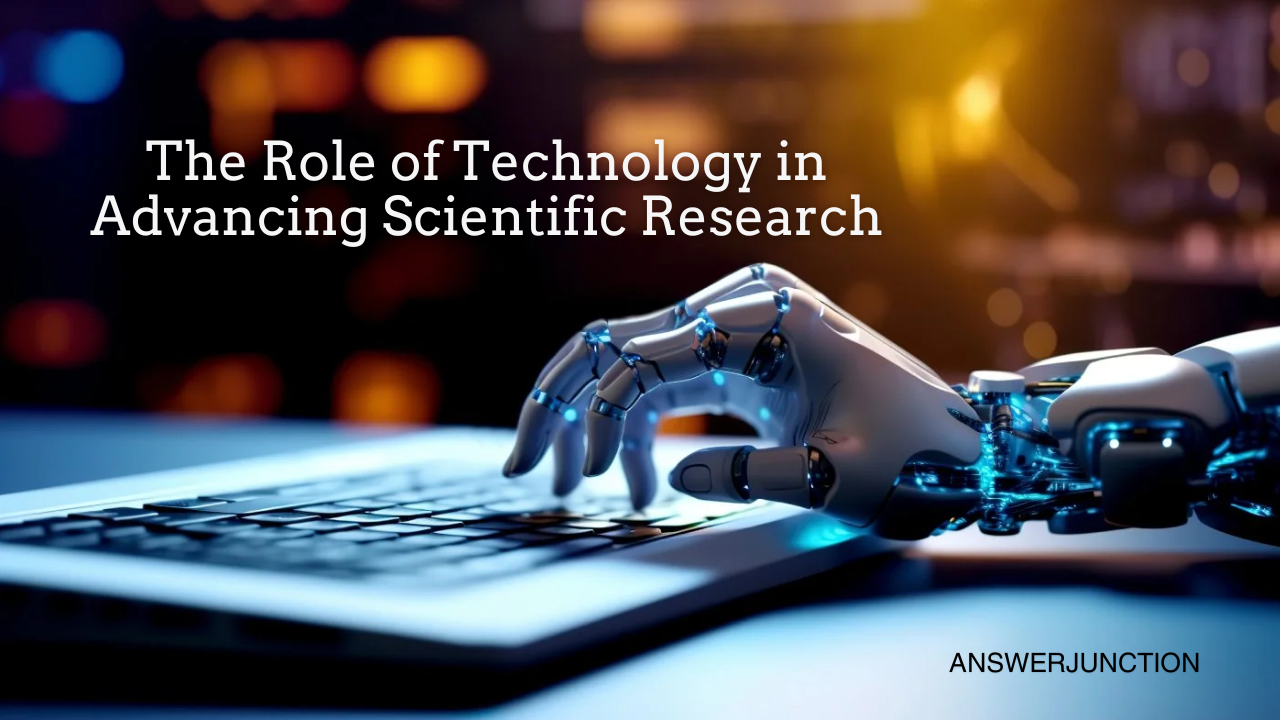In the modern era, technology plays an indispensable role in the advancement of scientific research. It has transformed how scientists conduct experiments, gather data, and share findings, significantly accelerating the pace of discovery. From the invention of the microscope to the latest developments in artificial intelligence (AI) and machine learning, technology has continuously reshaped the scientific landscape. This article explores the various ways technology enhances scientific research, examining key innovations, their impacts, and the future of science in a tech-driven world.
1. Historical Context: The Evolution of Scientific Tools
To understand the current role of technology in scientific research, it is essential to acknowledge its historical evolution. The scientific method has been a fundamental framework for research since the Renaissance. Early tools such as the microscope and telescope allowed scientists to explore the previously invisible realms of biology and astronomy.
1.1 The Microscope
The invention of the microscope in the 17th century by Antonie van Leeuwenhoek revolutionized biology by allowing scientists to observe microorganisms for the first time. This advancement laid the groundwork for microbiology and paved the way for significant discoveries, including the germ theory of disease.
1.2 The Telescope
Similarly, the telescope enabled astronomers to explore the universe, leading to groundbreaking findings about planetary motion and celestial bodies. The work of figures like Galileo Galilei not only changed our understanding of the universe but also exemplified the interplay between technology and scientific inquiry.
1.3 The Computer
The introduction of computers in the 20th century marked another significant leap in scientific research. They facilitated complex calculations, data analysis, and simulations that were previously impossible. Computers became essential tools in fields ranging from physics to biology, enabling researchers to handle vast amounts of data efficiently.
2. Data Collection and Analysis: Big Data and Advanced Computing
In contemporary research, one of the most significant advancements is the ability to collect and analyze large volumes of data, often referred to as “big data.” This shift has transformed scientific research across various disciplines.
2.1 The Role of Big Data
Big data refers to datasets that are too large or complex for traditional data-processing applications. The ability to analyze big data has enabled researchers to uncover patterns and correlations that were previously hidden. In fields like genomics, for instance, the Human Genome Project has generated enormous datasets, allowing scientists to understand genetic variations and their health implications.
2.2 Advanced Computing Techniques
Advanced computing techniques, including parallel computing and cloud computing, have enhanced data analysis capabilities. Researchers can now perform simulations and analyses that require massive computational power. For instance, climate scientists utilize complex models that simulate atmospheric conditions over decades, allowing them to make accurate predictions about climate change.
2.3 Artificial Intelligence and Machine Learning
Artificial intelligence and machine learning have revolutionized data analysis in scientific research. These technologies can analyze vast datasets quickly, identify patterns, and even make predictions based on the data. For example, in drug discovery, AI algorithms can analyze molecular structures and predict their interactions with biological targets, significantly speeding up the process of developing new medications.
How Technology is Influencing Modern Architecture and Design
3. Experimental Techniques: Automation and Robotics
Technological advancements have also transformed experimental techniques through automation and robotics, allowing for more efficient and reproducible experiments.
3.1 Automation in Laboratories
Automation in laboratories enables scientists to conduct experiments with minimal human intervention. Automated liquid handling systems, for instance, can perform repetitive tasks with high precision, reducing the risk of human error and increasing throughput. This is particularly beneficial in high-throughput screening in drug development, where thousands of compounds need to be tested quickly.
3.2 Robotics in Research
Robotics is another critical area where technology has advanced scientific research. Robotic systems can perform complex tasks, such as sample handling and analysis, with speed and accuracy. In fields like materials science, robots can autonomously synthesize and characterize new materials, accelerating the discovery process.
3.3 Laboratory Information Management Systems (LIMS)
LIMS technology has improved data management in laboratories. These systems help researchers organize, track, and manage samples, experiments, and results. By streamlining data management processes, LIMS enhances collaboration and ensures data integrity, allowing for more efficient research workflows.
4. Communication and Collaboration: Global Networks and Open Science

Technology has also transformed how scientists communicate and collaborate, breaking down geographical barriers and fostering global networks.
4.1 Global Collaboration
The internet has enabled scientists from around the world to collaborate on research projects in real-time. Online platforms facilitate communication and data sharing, allowing researchers to work together regardless of their physical location. This global collaboration has led to significant advancements in fields like epidemiology, where researchers from different countries can share data to track disease outbreaks effectively.
4.2 Open Science Movement
The open science movement promotes transparency and accessibility in research. Technology has enabled the sharing of research findings, data, and methodologies through open-access journals and repositories. This openness encourages collaboration and accelerates the dissemination of knowledge, allowing researchers to build on each other’s work more efficiently.
4.3 Social Media and Scientific Outreach
Social media platforms have become powerful tools for scientific communication. Researchers can share their findings with a broader audience, engage with the public, and foster interest in science. This increased visibility can lead to greater support for research funding and initiatives, ultimately benefiting the scientific community.
5. Innovative Research Techniques: Virtual and Augmented Reality
Emerging technologies, such as virtual reality (VR) and augmented reality (AR), are increasingly being used in scientific research, offering innovative ways to visualize and interact with data.
5.1 Virtual Reality in Research
VR technology allows researchers to create immersive environments for experimentation and visualization. For instance, in neuroscience, VR can simulate environments to study how the brain processes information. This technology provides researchers with new insights into human behaviour and cognition, enhancing our understanding of complex phenomena.
5.2 Augmented Reality for Data Visualization
AR technology enables researchers to overlay digital information onto the physical world, enhancing data visualization. This can be particularly useful in fields like medicine, where surgeons can use AR to visualize anatomical structures during procedures, improving precision and outcomes.
5.3 Enhanced Training and Education
VR and AR also offer novel approaches to training and education in scientific fields. Simulations can provide hands-on experience in a controlled environment, allowing students and researchers to practice techniques without the risks associated with real-world applications. This approach enhances learning and retention, preparing the next generation of scientists for future challenges.
6. Ethical Considerations and Challenges
While technology offers numerous benefits to scientific research, it also presents ethical considerations and challenges that must be addressed.
6.1 Data Privacy and Security
The increased reliance on big data raises concerns about data privacy and security. Researchers must ensure that sensitive information, especially in fields like healthcare, is protected. Compliance with regulations, such as the General Data Protection Regulation (GDPR), is essential to safeguard individuals’ rights and maintain public trust in scientific research.
6.2 Bias in AI and Machine Learning
The use of AI and machine learning in research is not without challenges. Algorithms can inadvertently incorporate biases present in the data they are trained on, leading to skewed results. Researchers must be aware of these biases and implement strategies to mitigate their impact on research outcomes.
6.3 Ethical Implications of Emerging Technologies
Emerging technologies, such as genetic engineering and AI, pose ethical dilemmas that require careful consideration. Scientists must navigate the complexities of these technologies to ensure they are used responsibly and for the benefit of society. Engaging with ethicists, policymakers, and the public is vital to establishing frameworks that guide the responsible use of technology in research.
7. The Future of Scientific Research: Embracing Technological Advancements

Looking ahead, the role of technology in advancing scientific research will only continue to grow. Several trends and innovations are shaping the future of science.
7.1 Integration of AI and Automation
The integration of AI and automation into research processes will streamline workflows and enhance productivity. As algorithms become more sophisticated, they will assist researchers in designing experiments, analyzing data, and interpreting results. This synergy will free scientists to focus on creative and critical thinking, leading to more innovative solutions to complex problems.
7.2 Advances in Biotechnology
Biotechnology will continue to advance through technological innovations, enabling researchers to manipulate biological systems with unprecedented precision. Techniques such as CRISPR gene editing will allow scientists to explore new frontiers in medicine, agriculture, and environmental science, addressing global challenges such as food security and disease prevention.
7.3 Continued Emphasis on Interdisciplinary Research
The future of scientific research will likely see a continued emphasis on interdisciplinary collaboration. As complex global challenges arise, researchers from diverse fields must come together to develop holistic solutions. Technology will facilitate these collaborations, enabling scientists to share expertise and insights across disciplines.
Technology has profoundly transformed the landscape of scientific research. From historical tools like the microscope to modern advancements in AI and automation, technology enhances the way scientists conduct experiments, analyze data, and communicate findings. As we move forward, embracing technological innovations will be essential for addressing the complex challenges facing our world. While ethical considerations must be at the forefront of these advancements, the potential for technology to propel scientific research into new realms of discovery is undeniable. The future of science is bright, driven by the unyielding spirit of innovation and collaboration.



